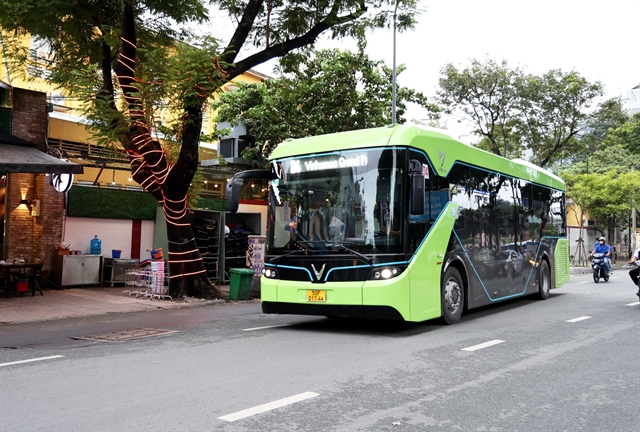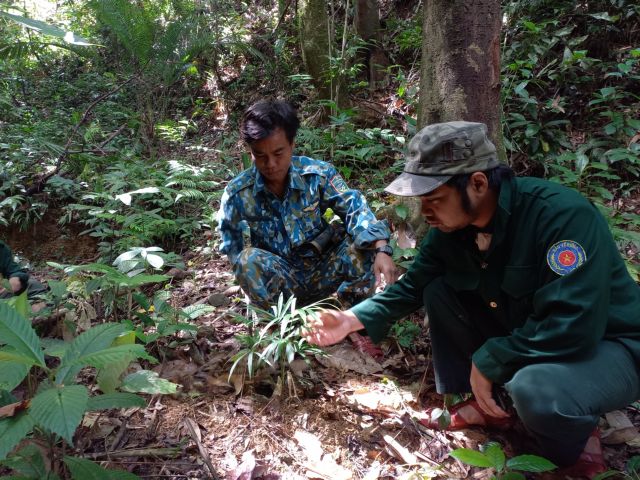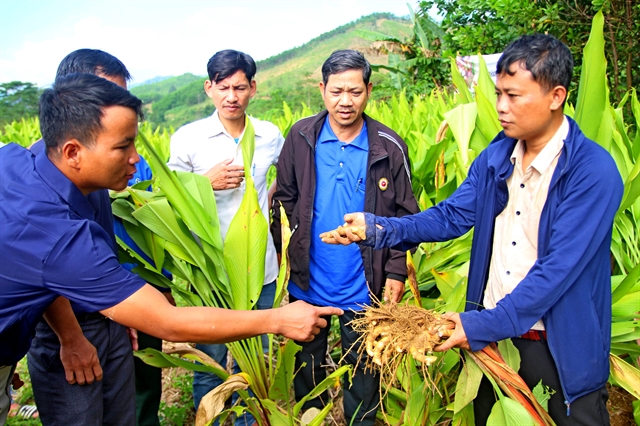 Environment
Environment


|
| A community-based forest protection team patrols in primary forest in Sông Kôn commune of Quảng Nam Province's Đông Giang district. The patrols are part of an effective protection of forest in Quảng Nam and Thừa Thiên Huế provinces. Photo courtesy of A Siu |
QUẢNG NAM — Community-based forest protection has helped improve the management and conservation of large areas of natural forest as it promotes the role and responsibility of local people on 7,833ha in Quảng Nam and Thừa Thiên Huế provinces.
An initial assessment from the report ‘Strengthening Civil Society to accelerate conservation efforts in Central Annamites, which was funded by the Swedish International Development Co-operation (SIDA) and jointly implemented by WWF-Việt Nam and NGO GreenViet, unveiled that 545ha degraded forest area in Thừa Thiên Huế had been restored during the first phase of the project in 2018-23.
The project, worth 1.73 million SEK (Swedish Krona) or US$1.67 million, also helped improve the income of communities in Đông Giang District, while expanding the forest for the grey-shanked douc langurs (Pygathrix cinerea) – a critically endangered primate species – in Tam Mỹ Tây Commune in Quảng Nam Province.
“Community-based forest management is seen as a positive solution in the conservation and protection of the primary forest. We recognised that the forest needed the involvement of the local people to be well protected, and limit illegal violations,” said Nguyễn Đình Phước, from WWF-Việt Nam’s Thừa Thiên Huế office.
“For example, a 545ha area of degraded forest in A Lưới and Nam Đông districts had been increased to medium forest standard (with timber reserves from 100 to 200 cubic metres per hectare) in the five-year period of the project,” he said.

|
| Villagers visit a rattan farm in a forest in Đông Giang district in Quảng Nam Province. Black saffron and rattan have been developed in Quảng Nam to improve the income of communities living near the primary forest. Photo courtesy of A Siu |
“The initial outcomes of the project persuaded the provincial people’s committee of Quảng Nam to continue community-based forest management at seven communities in Đông Giang and Núi Thành districts,” he shared.
He added the project also offered a livelihood for 1,480 households living near primary forest by boosting forest farms and sustainable forest product exploitation.
A 3-ha pilot farm of black saffron (Curcuma zedoaria) and a 50-ha rattan farm was developed by the Cơ Tu ethnic group in the villages of Bút Tưa, Bh Lô Bền, A Rớch and A Liêng in A Tinh and Sông Kôn communes in Quảng Nam province.
Briu Tư, 35, in Bh Lô Bền village, said 49 households, who joined the community-based forest protection teams, have benefitted from the farm black saffron project.
“We established agriculture co-operatives with members from forest protection teams. Saffron farming helps members earn an extra income,” Tư said.
“The pilot saffron farm created revenue of VNĐ225 million (US$9,900) from the processed root after seven months. We have been building the One-Commune-One-Product (OCOP) brand to serve community-based tourism,” he said.
Ploong Ninh, 39, a member of a forest protection team, said his team was assigned to patrol four jungle areas in a 2,200-ha forest in A Rớch village with well-equipped devices for easy reporting.
“Almost all residents in the village stopped illegal logging or hunting in the jungle since the project began in 2018. It’s because strange poachers can be easily found by us or warned by villagers,” he said. “Patrol teams were trained with global tracking tools and skills from WWF-Việt Nam and GreenViet to improve jungle management.”
A Rất Chung from the Sông Kôn forest management board said black saffron and rattan farms had been an adaptive option for local people to reduce over-exploitation in the jungle (with logging and wildlife hunting by traps).
Hoàng Quốc Huy, deputy director of GreenViet, a local NGO on biodiversity research, said 70 per cent of the community joined forest patrols with a fee of VNĐ400,000 per hectare.

|
| Local farmers harvest black saffron in Bút Tưa village of Quảng Nam Province. The root serves community-based tourism. Photo courtesy of A Siu |
“Patrol team members often earned VNĐ300,000 ($12) per day from non-timber products such as the bamboo sprout, bee honey, jungle herbs and snails during jungle trips,” Huy said.
He said the number of violations in the jungle has reduced by 30 per cent per year as livelihood options were offered during the five-year project period.
Huy said community-based forest management was highly appreciated by the local ethnic Cơ Tu group living near the forest.
“Being in the jungle is a habit and lifestyle for generations of Cơ Tu people, and they respect the forest as the village's God. Local people have been benefiting from forest products and jungle farms as well as payments from regular jungle patrols,” he explained. “They (local people) will have more chances for funds from NGOs such as WWF-Việt Nam through livelihood changes and management in forest conservation projects.”
In expanding conservation for 69 grey-shanked douc langurs in Núi Thành district, Quảng Nam province has allocated a 60ha forest and a logging farm into protected areas in 2020-30.
WWF-Việt Nam plans to expand community-based forest protection to a wider area in Quảng Trị and Quảng Nam in the second phase of the project, according to Phước.
The five-year project in Thừa Thiên Huế and Quảng Nam was seen as a positive sample for effective forest management by improving the livelihood of jungle-based communities, he concluded. — VNS




